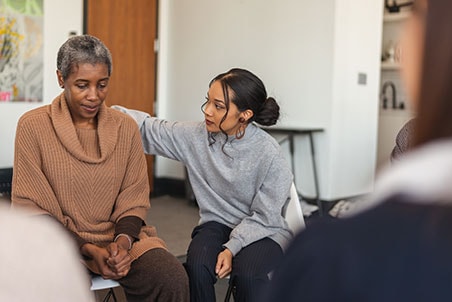Troubleshooting Group Problems
Every group will have its ups and downs, along with unexpected surprises. The group may have people who like to talk a lot, as well as people who are quiet but have much to offer. This section will help you with some of the most common problems when leading a group discussion.
We do not have a conference room for meetings.
You do not need one. Someone’s living room, a local school classroom, or anywhere that people can sit and feel comfortable expressing their feelings will work. See the Connecting Thread: Facilitating New Beginnings Online [PDF – 221 KB] for ideas for leading a virtual session when you can’t bring your group together in person. If you plan to show a video, you will need a computer with speakers and a projector. If you plan to play audio, you will need a computer with speakers or a mobile device. You can also ask people to watch the video or listen to the audio at home before the session by giving them the links. They will need a computer with access to the Internet to view the video and audio clips online.
If you can’t show a video, ask for a few volunteers to role-play the scene. It doesn’t matter if they don’t get it exactly right. Their role-playing will show what they think is important about the scene and how they might handle the situation. This approach might even give you a chance to have volunteers role-play the same scene in different ways. Ask the volunteers to role-play different emotions and different ways of helping the characters.
Someone in the group has burst into tears! What do I do?

This is a good sign. Those tears needed to come out. The rest of the group may be even more uncomfortable with tears than you are, so it helps to say something like: “Tears are important. Diabetes is a hard condition to deal with and we are talking about big emotional issues. We are all among friends here, so don’t be afraid to cry. Crying is part of the healing process that lets you go on.” Ask the person if they want to talk about what they are feeling. Tears could be their way of trying to open up about coping with diabetes.
Someone in the group has become angry. What do I do?
Like tears, anger is a way of expressing emotions that needed to come out. A person may be frustrated, tired, or stressed out, and anger can be a way to express those emotions. Let the person know that it’s okay to feel angry and that it’s a part of the healing process. Encourage them to try to figure out the root cause of the anger and direct their energy to finding solutions (see Module 5). Getting angry can also be a way to “change the subject.” People may lash out at others when they don’t want to deal with their feelings or their situation. Stay calm and do not take it personally. Remember that the anger is not about you or the other people in the group. If you react with anger, it changes the focus of the discussion to the conflict instead of the emotions the person is struggling to cope with.
Anger is a problem when it is misdirected or leads to behavior that is harmful to the person or to others. A person will need to get help from a doctor or counselor if they have trouble controlling their anger, or if it becomes harmful. A person who is being aggressive or upsetting other people in the group should be asked to take a moment to calm down and remember that everyone is here to try to help each other. You may have to ask the person to leave the group if their behavior continues to be a problem.
People take cell phone calls, and they interrupt the discussion.
At the beginning of the session ask everyone to turn off their cell phones or switch the phone to vibrate with the ringer off. If people must take calls during the session, ask them to take the calls outside of the room, out of earshot.
People do not want to share personal information.
It is natural for people to feel uncomfortable sharing personal information, especially with people they do not know. It is important that you establish trust in the group from the first session. Explain to participants that the information shared in the group is private and should not be shared with people who are not in the group.
Participants should not tell other people who is in the group, and they should respect all of the ground rules set by the group. The group leader should find out from participants how they would prefer to be contacted. For example, they may not want you to leave messages about the group on their home phone or with family members.
Do not pressure participants to talk about emotions or experiences they are not ready to share. The Think-Pair-Share activities in each module give participants a chance to think about how they are feeling without having to share personal information with everyone. You can focus on the goals or actions participants have decided to take without asking them to share information that might be too personal. Do not allow participants to criticize how other participants feel or react to situations. Participants may be more likely to share with the group when they feel the group is a safe place where they will not be judged and where their privacy will be respected.
People bring their children, and the noise of the children playing is disturbing the group.
Prepare ahead of time for this possibility. Even if you have told people not to bring children, it happens sometimes. Figure out what options you have for keeping children busy and away from the group. If possible, arrange to have games, toys, or art projects available; set up a TV or DVD player in another room to play a children’s video; or arrange for babysitters to watch the children. If you meet at a location with a playground, the babysitters can take the children outside. Older children or teenagers should be invited to participate in the session. If the group meets regularly, ask the group how they want to deal with the situation. One possibility is to develop a rotating schedule that arranges for a different person each session to stay with the children or to bring someone to stay with the children during the session.

People expect food at sessions like this, or they bring food that is not healthy.
Food helps people feel more relaxed, and you want a comfortable setting where people can open up. If this is a single session, provide water or sugarless drinks and a healthy snack option (for example, fruit, vegetables, baked chips, or crackers with dips like hummus that are a good source of healthy fats). If you are meeting regularly, discuss the food issue with the group at the first session and ask that people only bring healthy snacks.
One person is doing all the talking.
There are a few ways to deal with this situation. Sometimes, the person who is talking a lot is bringing out good points, and you do not want them to stop. But you do want everyone to have a chance to speak. One approach is to sometimes go around the room and ask each person if he or she has anything to say on the topic being discussed.
You can also ask the group to adopt ground rules for the discussion. For example, participants could agree that only one person speaks at a time, with no interruptions; that all opinions are welcome; and that there are no right or wrong opinions.
You might also set a rule that people can speak for only 2 minutes at a time. Two minutes should be enough time to share an opinion or personal stories. A time limit can help ensure that everyone has enough time to speak and no one person takes over the discussion.
If some participants continue to break the rules, remind the group of the rules. If a person continues to disrupt the group, call a break in the session, and speak to the person individually.
Here are two possible ways to handle this situation:
- If the person is difficult and disruptive, ask them to keep their comments short because others in the group want to speak. Consider setting a “2-minute rule” if you haven’t already. Tell the disruptive person that, if they can’t follow this rule, you will have to ask them to leave.
- If you think the person has good intentions but is having trouble with self-control, ask them to help with the group. You can ask them to take notes on the flipchart, pass out handouts, or perform other duties. Use the person’s energy and goodwill to help you.
People are arguing and getting upset when they disagree.
Remind the group that we are dealing with emotions here. There is no right or wrong when it comes to how someone feels. It’s just the way he or she feels, and we need to be respectful. The point of the discussions is to bring out the many different kinds of emotions that people experience, to talk about how those emotions can help or hurt them, and to explore how to turn emotionally charged events into positive actions. Ask the group, “Can we turn all the powerful energy we are feeling during this discussion into something positive?”
Some people do not have family or friends who can come to the session with them.
It is okay if people do not have family members or friends who attend the sessions. They can still participate in the activities and take the information home to share with loved ones. If you are doing family-based group activities, you can have participants who come alone work together, or you can work with them during the group activity.
Someone has asked a question about her personal health. For example, should she worry about the chest pain she gets sometimes when she is upset. What should I do?
Encourage participants to direct questions about personal symptoms to their health care provider. Do not give health information unless you are qualified to do so. Giving clinical advice is not the purpose of these sessions. Refer the person to a health care provider for medical questions.
Someone has asked a question and I do not know the answer. What should I do?
Tell the group that you do not know the answer but will help them find one. You are strongly encouraged to invite a local health care provider, certified diabetes care and education specialist, or someone from the local American Diabetes Association chapter to a session. The focus of the modules in this discussion guide is on emotions and behavior. But you also want people to learn how to find the answers to questions about their health. You may be able to help the group find information on the websites of the Centers for Disease Control and Prevention or the National Institutes of Health or from websites listed in the Resources section this guide.